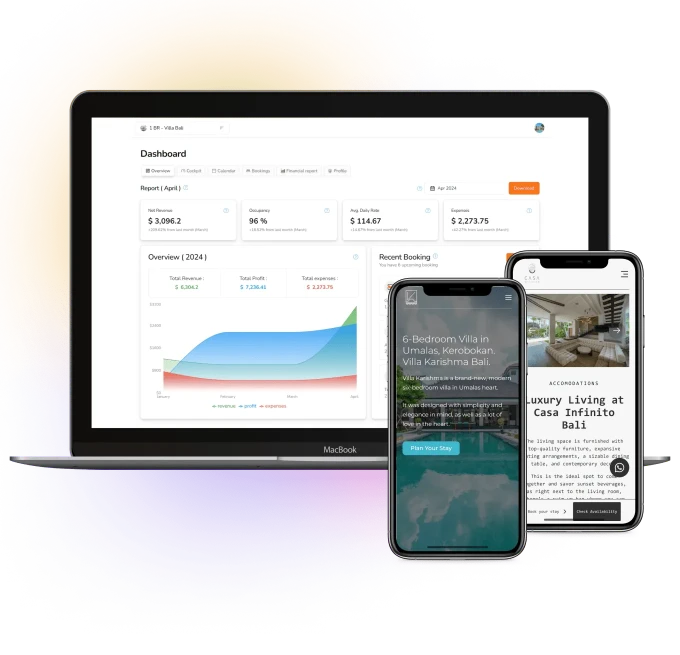A Call to Action (CTA) is a prompt that encourages users to take a specific action on a website, social media post, or advertisement. In the context of Bali villa rentals, CTAs are crucial for guiding potential guests toward booking, inquiring, or engaging with your property.
Examples include:
- “Book Now” – Encourages immediate reservations.
- “Check Availability” – Allows users to verify dates before committing.
- “Get a Special Offer” – Attracts interest by highlighting a deal.
Why CTAs Matter for Bali Villas
CTAs are essential for converting website visitors into paying guests. A well-placed and well-worded CTA can:
- Drive Direct Bookings – Encourages guests to book directly, reducing reliance on OTAs.
- Enhance Engagement – Leads visitors to explore more about the villa’s amenities or special packages.
- Increase Revenue – Encourages upselling of services like private chefs, spa treatments, or excursions.
How to Create an Effective CTA
- Use Action-Oriented Language – Phrases like “Reserve Your Stay” or “Plan Your Escape” create urgency.
- Make it Visually Striking – Use contrasting colors, bold fonts, or buttons that stand out on the page.
- Keep it Concise and Clear – Avoid long phrases; stick to direct messages like “Instant Booking”.
- Place it Strategically – Position CTAs on high-visibility areas like the homepage, booking pages, and exit pop-ups.
- Offer an Incentive – Encourage action by adding value, such as “Book Now & Get a Free Airport Transfer”.
Best Practices for CTA Placement
- Above the Fold – Ensure a CTA is visible as soon as visitors land on your site.
- At the End of Blog Posts – If a blog discusses villa experiences, add “Discover Our Villas” as a CTA.
- In Email Marketing – A button with “Claim Your Exclusive Offer” can encourage clicks.
Measuring CTA Success
To determine how effective your Call to Action (CTA) is in driving bookings and engagement, it’s essential to track key performance indicators (KPIs). Below are the most important metrics to analyze:
1. Click-Through Rate (CTR)
Definition: The percentage of users who click on your CTA compared to the total number of visitors who see it.
Formula:

Why It Matters:
- A high CTR indicates that your CTA is compelling and encourages action.
- A low CTR suggests that the CTA might be unclear, unappealing, or poorly placed.
How to Improve It:
- Use clear, action-driven wording (“Book Your Stay” instead of “Click Here”).
- Ensure CTAs are visually distinct (color contrast, bold text, and large buttons).
- Optimize placement by testing different locations on your website.
2. Conversion Rate
Definition: The percentage of users who complete the desired action (e.g., booking a villa) after clicking the CTA.
Formula:

Why It Matters:
- A high conversion rate means your CTA is not only attracting clicks but also leading to real results.
- A low conversion rate might mean that users are interested but encounter obstacles, such as a complex booking process.
How to Improve It:
- Ensure the landing page is relevant and loads quickly.
- Simplify the booking process (fewer form fields, clear pricing).
- Offer incentives like “Limited-Time Discounts” to encourage commitment.
3. A/B Testing (Split Testing)
Definition: A method of comparing two versions of a CTA (different text, color, placement, etc.) to see which performs better.
How It Works:
- Run two variations of your CTA (e.g., “Book Now” vs. “Reserve Your Stay”).
- Analyze which version generates more clicks and conversions.
- Apply the better-performing CTA site-wide.
Example:
- Version A: “Instant Booking – No Hidden Fees” → 5% CTR
- Version B: “Book Now & Get 10% Off” → 8% CTR
Since Version B has a higher CTR, it becomes the preferred CTA.
4. Bounce Rate After CTA Clicks
Definition: The percentage of users who click on a CTA but leave without taking further action.
Why It Matters:
- A high bounce rate after clicking a CTA suggests the landing page does not meet user expectations.
- Possible issues include slow page speed, lack of trust signals, or unclear booking steps.
How to Improve It:
- Ensure the landing page aligns with the CTA promise (if the CTA says “Exclusive Offer,” make sure the page highlights it).
- Improve page load speed to keep users engaged.
- Add trust-building elements like guest reviews, security badges, and price guarantees.
5. User Engagement with CTA Elements
Beyond direct clicks and conversions, it’s useful to analyze how users interact with CTAs using heatmaps and session recordings:
- Heatmaps: Show where users hover and click the most. If users ignore the CTA, consider repositioning it.
Session Recordings: Track user behavior to identify hesitation points (e.g., do users abandon the booking form midway?).
Bottom Line
A well-crafted Call to Action plays a crucial role in increasing direct bookings and guest engagement for Bali villas. By using persuasive language, strategic placement, and compelling offers, villa owners can guide visitors toward making reservations with ease.
